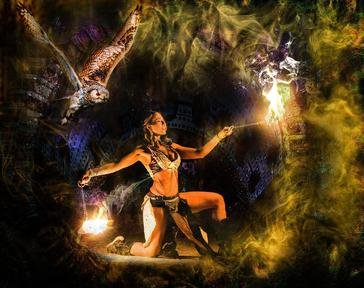Quiz Answer Key and Fun Facts
1. Go-go boots, fashionable footwear with high tops and moderate heels, showed up in the early 1960s, around the same time that go-go dancers first appeared. Go-go dancers often wear go-go boots, but tell me: is go-go dancing usually done to go-go music?
2. Lots of theatrical productions - especially musicals - involve dancing, and actresses and actors turn to character shoes to balance style and comfort. A woman's character shoe has a wide heel and a strap to keep the shoe on the foot, as well as what feature that makes the shoe unsuitable for outdoor wear?
3. In a particular type of folk dance from southern Spain, dancers make part of the music, providing percussion with their feet. Accordingly, the women don't just perform the "baile" in ordinary high heels; their shoes have nails driven into the toes and heels. What type of dance is this?
4. Some shoes have very specialized roles to play. Which of these dancers is most likely to own a good pair of pointe shoes?
5. Gumboot dancers take the name of their form from the water-resistant boots they wear, also known as wellington boots; sometimes the basic boots have bells attached. The dancing style, known for its complex rhythms and percussion, originated in the mines of what country?
6. Ballet slippers are the most basic tool of ballet dancers, from novices to experts - but there are quite a few different kinds of basic ballet flats! Why would a dancer choose a split-sole slipper over a full-sole slipper?
7. Clogging is another dance form where the sound made by the dancer's shoes is a critical element of the routine. Around the world, clog dancing and clog shoes come in many different flavors. In the Dutch variety, Klompendansen, what are the shoes made of?
8. In many ways, a ghillie is built like a ballet shoe, but one difference is hard to miss: they're tied with laces that cross each other all along the top of the foot, with one last tie at the ankle. Which of these types of competitive dance, often involving swords, would most likely be danced in ghillies?
9. Foot thongs, also known as dance paws, are a godsend to a wide variety of dancers. From a seat several rows back, what does a foot in a dance paw most resemble?
10. As tap dancers move across the floor, their heels and toes tap out sophisticated rhythms. Not surprisingly, this takes special shoes! What is it that makes the distinctive sound of tap dancing?
Source: Author
CellarDoor
This quiz was reviewed by FunTrivia editor
looney_tunes before going online.
Any errors found in FunTrivia content are routinely corrected through our feedback system.
